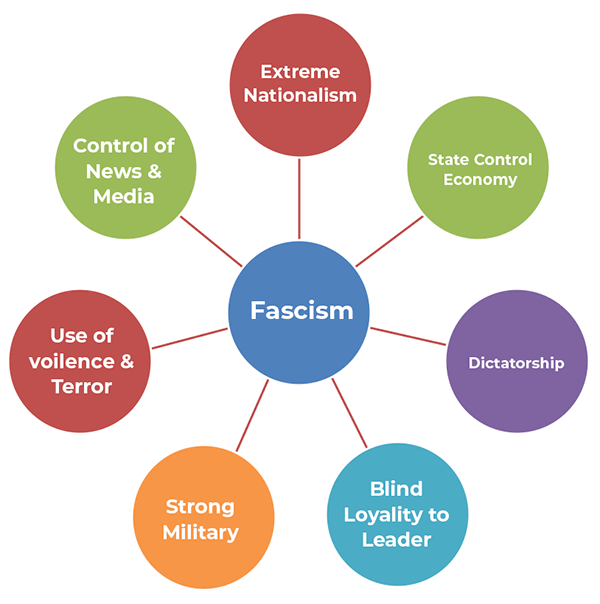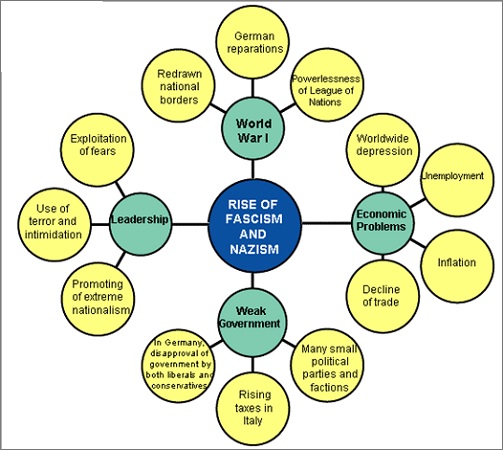Fascism and Nazism
by Devender
0 2500
The term Fascism is of Italian origin and it was first used for a movement that began in Italy by Benito Mussolini. He organized armed gangs against communists and socialists in 1919.
Fascism in Italy
- Conditions that led to rise of Fascism in Italy
- Over 7 lakh Italians died in World War I
- Italy didn't gain any territories in the peace treaty
- Conditions of people got worsened after war
- Socialist movement in Italy grew strength and it posed a threat to the existing system
- Italian government at that time was under the influence of capitalists & landlords
- These capitalists & landlords started supporting anti-democratic movements
- These movements promised to save them from socialism and satisfy their colonial desires
- Benito Mussolini's rise:
- In spite of the terrors caused by Mussolini, his party was only able to win only 35 seats
- Socialists and communists were able to get 138 seats together
- Mussolini talked of seizing power openly
- Mussolini organized a march on Rome in October, 1922
- The government of Italy didn't resist the volunteers of Mussolini
- Even the king of Italy invited Mussolini to join the government
- Thus, without doing many fascists under Mussolini came to power in Italy
- The socialist movement was crushed and their leaders were either killed or jailed
- In 1926, all parties were banned except Mussolini's
- Impact of rise of fascism:
The Italian government didn't show much care about the agricultural and industrial workers. Their conditions were extremely miserable. Instead of looking at them, the government decided to enter the war in order to gain colonies.
The movement under the leadership of Mussolini was also one such movement. His armed gangs were used by these capitalists and landlords to fight against socialists and communists. Campaign of terrorism and murder was launched but the government didn't pay much attention to it.

Elections were held in Italy in the year 1921 but no single party was able to win a majority and hence, no stable government was formed.
This was victory of Fascism in Italy and it was not because of any victory in elections or an uprising. The government of Italy was given to fascists because the ruling classes thought democracy and socialism are threats to their power.
Fascists didn't believe in harmony between two or more nations. They clearly glorified war and wanted to expand territory. Their thinking was if a nation is not expanding, they are not going to survive for long. This victory of fascism killed democracy and socialism. It also led to the preparation of war.
Nazism in Germany
Nazism was the German version of fascism but it was more sinister than Italian fascism. Nazis were under the leadership of Adolf Hitler, they established the most barbarous dictatorship of all time.
- Revolution outbreak at the end of World War I led to the end of the German monarchy
- Germany became a republic but the forces behind the monarchy were still powerful
- The government failed to destroy their power
- These forces joined hands with Nazis to grow more powerful and keep socialism in check
- The term Nazism stood for National Socialist German Workers’ Party founded by Hitler in 1921
- Nazism's rise in Germany:
- He glorified the use of force & brutality and rule of a greater leader
- He condemned the ideas of internationalism, peace, and democracy
- He blamed German Jews for defeat in World War I and all the ills of Germany
- He glorified war and violent nationalism
- Factors that led to rise of Nazism:
- Soon after coming to power, Hitler ordered new elections and started a reign of terror
- Anti-Nazi leaders were assassinated on a large scale
- Parliament building was set on fire by the Nazis
- The blame for the fire was put on the communist party and it was suppressed
- Despite all this terror, Hitler couldn't win a majority of seats in parliament
- He took dictatorial powers in 1934 and became the president of Germany
- Trade unions were shut
- Communist, socialist, and Anti-Nazi leaders were murdered
- Nazis even burnt the best works of some of the best writers of Germany and other countries
- German Jews also became a victim of his violence
Hitler also planned to gain power like Mussolini by marching on Berlin. Before he could do anything, he got arrested and sent to jail but he was released long before his term was over. During his time in Jail, he wrote his book Mein Kampf (My Struggle) that sowed some monstrous ideas of the Nazi movement.
These dreadful ideas of Nazis found home in the heart of the army, the industrialist, big landowners, and anti-republican politicians. They started seeing Hitler as the savior of Germany.
Nazis made use of the humiliation that Germans felt at their defeat in war and the Treaty of Versailles. They exploited the misery of people. In 1929, an economic crisis took place which affected all the Industrialists and capitalists all over the world.
As a result of this crisis, nearly half the working population of Germany went unemployed. It was during this time that the Nazi party started spreading its influence.
The socialist and communist were powerful parties and in the election, before Hitler came to power, these parties won the majority of votes. Nazis were only able to win 196 seats out of 650. However, socialists and communists couldn't unite against the Nazi party.
So, it can be said that the victory of Nazism in Germany was similar to the victory of Fascism in Italy. It was neither done by march on berlin nor of a popular uprising but by political intrigues.
Despite the poor performance in elections, Hitler was appointed as the Chancellor of Germany by the president of Germany. The whole idea of democracy in Germany was mocked up in just a few weeks after this.

Within a few years, Hitler murdered all the leaders and Jews. He launched a major program of militarization and soon preparation for war began. The victory of Nazism was not only bad for the people of Germany but it was a calamity for entire Europe and other countries.
Comparison of Nazism and Fascism
- Differences between Nazism and Fascism:
- Nazism took deep roots in Germany unlike Fascism in Italy
- The German system was more efficient than the Italian system
- Nazism was much more ruthless than Fascism
- Mussolini's Fascism was not anti-racist while Nazism was against Jews
- Similarities between Nazism and Fascism:
- Anti-communist and supported by capitalists and industrialists
- Both aimed for a totalitarian state and controlled industry, agriculture and the way of life of the people
- Both wanted to make the country self-sufficient
- Both glorified war, nationalism, cult of the leader and the supremacy of the state
- Education was supervised
- Re-birth of the nation was given prime importance
- Young minds were being controlled

Share:







Comments
Waiting for your comments